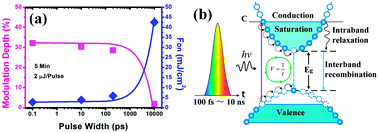Technique and model for modifying the saturable absorption (SA) properties of 2D nanofilms by considering interband exciton recombination†
Abstract
In this study, we have successfully demonstrated a method of greatly modifying the nonlinear saturable absorption (SA) properties of WS2 nanofilms by controlling their thickness and morphology via magnetron sputtering deposition times. The nonlinear SA properties of these nanofilms were also investigated systematically under excitation by laser pulses with various durations in the fs, ps and ns ranges, and prominent ultrafast SA parameters were demonstrated for different pulse durations in the fs, ps and ns ranges. A pulse width-dependent theoretical model of SA that considers the effects of interband exciton recombination has now been proposed for the first time. Two analytical expressions for calculating the variation of key SA parameters (the onset fluence Fon and the modulation depth ΔT) with the excitation laser pulse width have been derived and experimentally verified. The theoretical model and analytical expressions have great value for understanding and interpreting the variation of the SA behaviors of 2D nanofilms in the fs, ps and ns regions, and for the developments of ultrafast lasers and nanosecond lasers based on 2D materials. These studies open up exciting avenues for engineering the SA properties of 2D nanofilms for a wide range of laser photonic devices and applications.



 Please wait while we load your content...
Please wait while we load your content...